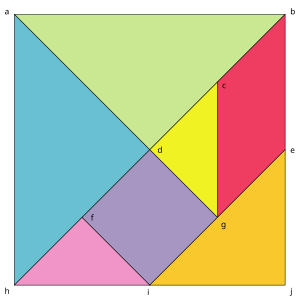Tangram
From Wikipedia, the free encyclopedia
The tangram (Chinese: 七巧板; pinyin: qī qiǎo bǎn; literally "seven boards of skill") is a dissection puzzle consisting of seven flat shapes, called tans, which are put together to form shapes. The objective of the puzzle is to form a specific shape (given only in outline or silhouette) using all seven pieces, which may not overlap.
Contents |
[edit] History
The Tangram may have roots in the in the yanjitu (燕几圖) furniture set of the Song Dynasty. This furniture set saw some variation during the Ming Dynasty, and later became a set of wooden blocks for playing.
While the tangram is often said to be ancient, the earliest known printed reference to tangrams appears in a Chinese book dated 1813, which was probably written during the reign of the Jiaqing Emperor.[1]
The tangram's existence in the West has been verified to no earlier than the early 19th century, when they were brought to America on Chinese and American ships. The earliest known example, given to the son of an American ship owner in 1802, is made of ivory and has a silk box.[citation needed]
The word tangram was first used in 1848 by Thomas Hill, later President of Harvard University, in his book Geometrical Puzzle for the Youth.
The author and mathematician Lewis Carroll reputedly was a tangram enthusiast and owned a Chinese book with tissue-thin pages containing 323 tangram designs. Napoleon is said[by whom?] to have owned a tangram set and Chinese problem and solution books during his exile on the island of St. Helena, although this has been contested by Ronald C. Read. Photos[of what?] are shown in The Tangram Book by Jerry Slocum.
Sam Loyd's 1903 spoof of tangram history, The Eighth Book Of Tan, claims that the game was invented 4,000 years ago by a god named Tan. The book included 700 shapes, some of which are impossible to solve. [2]
[edit] Paradoxes
A tangram paradox is an apparent dissection fallacy: two figures composed with the same set of pieces, one of which seems to be a proper subset of the other. [3] One famous paradox is that of the two monks, attributed to Dudeney, which consists of two similar shapes, one with and the other missing a foot. [4] A solution to the paradox can be found in many sources, e.g. at ref. [3]
Another is proposed by Sam Loyd in The Eighth Book Of Tan:
The seventh and eighth figures represent the mysterious square, built with seven pieces: then with a corner clipped off, and still the same seven pieces employed.[5]
A solution to the paradox is not reported in Loyd's book.
[edit] Counting configurations
Fu Traing Wang (often incorrectly cited as "Fu Tsiang Wang") and Chuan-chin Hsiung proved in 1942 that there are only thirteen convex tangram configurations (configurations such that a line segment drawn between any two points on the configuration's edge always pass through the configuration's interior, i.e., configurations with no recesses in the outline).[6][7]
Ronald C. Read's book Tangrams: 330 Puzzles asks the reader for any other sets of tangrams that, while more numerous than convex configurations, yet are not infinite in number. [8]
An estimate of ten million possible "fully matched" configurations has been offered,[9] where "fully matched" means that at least one edge and at least one vertex of any piece is matched to an edge and vertex of another.
[edit] The pieces
Sizes are relative to the big square, which is defined as being of width, height and area equal to  [10].
[10].
- 5 right triangles
- 2 small (hypotenuse of
 and sides of
and sides of  )
) - 1 medium (hypotenuse of
 and sides of
and sides of  )
) - 2 large (hypotenuse of
 and sides of
and sides of  )
)
- 2 small (hypotenuse of
- 1 square (side of
 )
) - 1 parallelogram (sides of
 and
and  )
)
Of these seven pieces, the parallelogram is unique in that it has no reflection symmetry but only rotational symmetry, and so its mirror image can only be obtained by flipping it over. Thus, it is the only piece that may need to be flipped when forming certain shapes. With a one-sided set of tangrams (no flipping allowed), there are shapes that can be formed while their mirror images cannot.
[edit] See also
[edit] References
- ^ Chen, Zhongying (1999). Advances in computational mathematics: proceedings of the Guangzhou international symposium. New York, N.Y: Marcel Dekker. pp. 466. ISBN 0-8247-1946-8.
- ^ Costello, Matthew J. (1996). The Greatest Puzzles of All Time. New York: Dover Publications. ISBN 0-486-29225-8.
- ^ a b Tangram Paradox, by Barile, Margherita, From MathWorld - A Wolfram Web Resource, created by Eric W. Weisstein.
- ^ Dudeney, H. (1958). Amusements in Mathematics. New York: Dover Publications.
- ^ Loyd, Sam (1968). The eighth book of Tan - 700 Tangrams by Sam Loyd with an introduction and solutions by Peter Van Note. New York: Dover Publications. pp. 25.
- ^ Fu Traing Wang; Chuan-Chih Hsiung (November 1942). "A Theorem on the Tangram". The American Mathematical Monthly 49 (9): 596–599. http://www.jstor.org/stable/2303340. Retrieved on 2009-02-06.
- ^ Read, Ronald C. (1965). Tangrams : 330 Puzzles. New York: Dover Publications. pp. 53. ISBN 0-486-21483-4.
- ^ Read, Ronald C. (1965). Tangrams : 330 Puzzles. New York: Dover Publications. pp. 55. ISBN 0-486-21483-4.
- ^ Cocchini, F. Ten Millions of Tangram Patterns. TangMath.
- ^ "Tangram" by Enrique Zeleny, Wolfram Demonstrations Project
[edit] Further reading
- Anno, Mitsumasa. Anno's Math Games (three volumes). New York: Philomel Books, 1987. ISBN 0399211519 (v. 1), ISBN 0698116720 (v. 2), ISBN 039922274X (v. 3).
- Botermans, Jack, et al. The World of Games: Their Origins and History, How to Play Them, and How to Make Them (translation of Wereld vol spelletjes). New York: Facts on File, 1989. ISBN 0816021848.
- Dudeney, H. E. Amusements in Mathematics. New York: Dover Publications, 1958.
- Gardner, Martin. "Mathematical Games-on the Fanciful History and the Creative Challenges of the Puzzle Game of Tangrams", Scientific American Aug. 1974, p. 98–103.
- Gardner, Martin. "More on Tangrams", Scientific American Sep. 1974, p. 187–191.
- Gardner, Martin. The 2nd Scientific American Book of Mathematical Puzzles and Diversions. New York: Simon & Schuster, 1961. ISBN 0671245597.
- Loyd, Sam. Sam Loyd's Book of Tangram Puzzles (The 8th Book of Tan Part I). Mineola, New York: Dover Publications, 1968.
- Slocum, Jerry, et al. Puzzles of Old and New: How to Make and Solve Them. De Meern, Netherlands: Plenary Publications International (Europe); Amsterdam, Netherlands: ADM International; Seattle: Distributed by University of Washington Press, 1986. ISBN 0295963506.
- Slocum, Jerry, et al. The Tangram Book: The Story of the Chinese Puzzle with Over 2000 Puzzles to Solve. New York: Sterling Publishing Company, 2003. ISBN 1-4027-0413-5.






